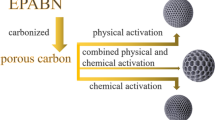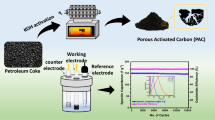Abstract
High-performance activated carbon for electrochemical double-layer capacitors (EDLC) has been prepared from cation exchange resin by carbonization and subsequent activation with KOH. The activation temperature has a key role in the determination of porous carbon possessing high surface areas, and large pore structures. The porous carbon activated at 700 °C (carbon-700-1:4) has high surface area (2236 m2 g−1) and large total pore volume (1.15 cm3 g−1), which also displays best capacitive performances due to its well-balanced micro- or mesoporosity distribution. In details, specific capacitances of the carbon-700-1:4 sample are 336.5 F g−1 at a current density of 1 A g−1 and 331.8 F g−1 at 2 A g−1. At high current density as 20 A g−1, the retention of its specific capacitance is 68.4 %. The carbon-700-1:4 sample also exhibits high performance of energy density (46.7 Wh kg−1) and long cycle stability (∼8.9 % loss after 3,000 cycles). More importantly, due to the amount of waste ion-exchange resins increasing all over the world, the present synthetic method might be adopted to dispose them, producing high-performance porous carbons for EDLC electrode materials.








Similar content being viewed by others
References
Gogotsi Y, Simon P (2011) Science 334:917–918
Kötz R, Carlen M (2000) Electrochim Acta 45:2483–2498
Simon P, Gogotsi Y (2008) Nat Mater 7:845–854
Frackowiak E, Béguin F (2001) Carbon 39:937–950
Nishihara H, Kyotani T (2012) Adv Mater 24:4473–4498
Xia Y, Yang Z, Mokaya R (2010) Nanoscale 2:639–659
Zhai Y, Dou Y, Zhao D, Fulvio PF, Mayes RT, Dai S (2011) Adv Mater 23:4828–4850
Wang J, Kaskel S (2012) J Mater Chem 22:23710–23725
Zhang LL, Zhao XS (2009) Chem Soc Rev 38:2520–2531
Zhu Y, Murali S, Stoller MD, Ganesh KJ, Cai W, Ferreira PJ, Pirkle A, Wallace RM, Cychosz KA, Thommes M, Su D, Stach EA, Ruoff RS (2011) Science 332:1537–1541
Xing W, Huang CC, Zhuo SP, Yuan X, Wang GQ, Hulicova-Jurcakova D, Yan ZF, Lu GQ (2009) Carbon 47:1715–1722
Lv Y, Zhang F, Dou Y, Zhai Y, Wang J, Liu H, Xia Y, Tu B, Zhao DY (2012) J Mater Chem 22:93–99
Yoon SH, Lim S, Song Y, Ota Y, Qiao W, Tanaka A, Mochida I (2004) Carbon 42:1723–1729
Li X, Han C, Chen X, Shi C (2010) Microporous Mesoporous Mater 131:303–309
Nakagawa H, Watanabe K, Harada Y, Miura K (1999) Carbon 37:1455–1461
Nezu A, Morishima T, Watanable T (2003) Thin Solid Films 435:335–339
Hu M, Reboul J, Furukawa S, Torad NL, Ji Q, Srinivasu P, Ariga K, Kitagawa S, Yamauchi Y (2012) J Am Chem Soc 134:2864–2867
Díaz-Terán J, Nevskaia DM, Fierro JLG, López-Peinado AJ, Jerez A (2003) Microporous Mesoporous Mater 60:173–181
Lillo-Ródenas MA, Cazorla-Amorós D, Linares-Solano A (2003) Carbon 41:267–275
Romanos J, Beckner M, Rash T, Firlej L, Kuchta B, Yu P, Suppes G, Wexler C, Pfeifer P (2012) Nanotechnol 23:015401
Yang S, Hu H, Chen G (2002) Carbon 40:277–284
Liang Y, Feng X, Zhi L, Kolb U, Müllen K (2009) Chem Commun (7):809–811
Li F, Morris M, Chan KY (2011) J Mater Chem 21:8880–8886
Radhakrishnan L, Reboul J, Furukawa S, Srinivasu P, Kitagawa S, Yamauchi Y (2011) Chem Mater 23:1225–1231
Jiang HL, Liu B, Lan YQ, Kuratani K, Akita T, Shioyama H, Zong F, Xu Q (2011) J Am Chem Soc 133:11854–11857
Okpalugo TIT, Papakonstantinou P, Murphy H, McLaughlin J, Brown NMD (2005) Carbon 43:153–161
Datsyuk V, Kalyva M, Papagelis K, Parthenios J, Tasis D, Siokou A, Kallitsis I, Galiotis C (2008) Carbon 46:833–840
Pevida C, Drage TC, Snape CE (2008) Carbon 46:1464–1474
Deitzel JM, Kosik W, McKnight SH, Beck Tan NC, DeSimone JM, Crette S (2002) Polymer 43:1025–1029
Yang D, Velamakanni A, Bozoklu G, Park S, Stoller M, Piner RD, Stankovich, Jung I, Field DA, Ventrice CA Jr, Ruoff RS (2009) Carbon 47:145–152
Coullerez G, Léonard D, Lundmark S, Mathieu HJ (2000) Surf Interface Anal 29:431–443
Lozano-Castelló D, Cazorla-Amorós D, Linares-Solano A, Shiraishi S, Kurihara H, Oya A (2003) Carbon 41:1765–1775
Fuertes AB, Lota G, Centeno TA, Frackowiak E (2005) Electrochim Acta 50:2799–2805
Chen LF, Zhang XD, Liang HW, Kong M, Guan QF, Chen P, Wu ZY, Yu SH (2012) ACS NANO 6:7092–7102
Kötz R, Hahn M, Gallay R (2006) J Power Sources 154:550–555
Acknowledgments
This work was supported by Anhui Province Key Laboratory of Environment-friendly Polymer Materials, Anhui University, Hefei 230039, China (KF2012009). Dr. Xiang Ying Chen also thanks the financial support from the National Natural Science Foundation of China (21101052) and China Postdoctoral Science Foundation (20100480045).
Author information
Authors and Affiliations
Corresponding authors
Electronic supplementary material
Below is the link to the electronic supplementary material.
Figure S1
(a) Cyclic voltammograms at the scan rates of 50 mV s−1; (b) galvanostatic charge–discharge curves measured at the current density of 4 A g−1; (c) specific capacitances at various current densities; (d) cycling stability of the carbon samples. (DOC 881 kb)
Figure S2
(a) Ragone plots showing energy density vs. power density of the carbon samples; (b) Nyquist plots before/after 50 cycles of the carbon samples. (DOC 113 kb)
Rights and permissions
About this article
Cite this article
Zhang, Z.J., Cui, P., Chen, X.Y. et al. The production of activated carbon from cation exchange resin for high-performance supercapacitor. J Solid State Electrochem 17, 1749–1758 (2013). https://doi.org/10.1007/s10008-013-2039-x
Received:
Revised:
Accepted:
Published:
Issue Date:
DOI: https://doi.org/10.1007/s10008-013-2039-x




